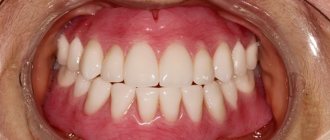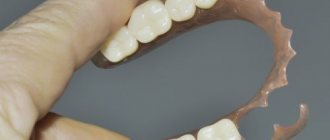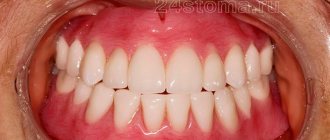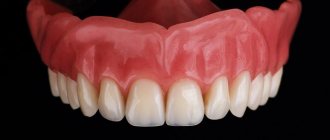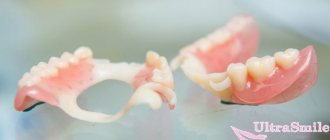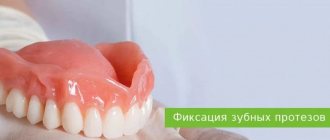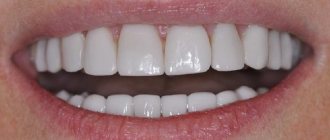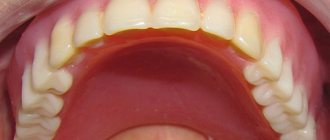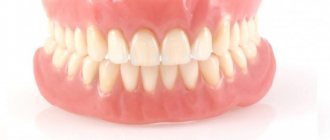6360
Poor fixation is one of the global problems of removable dentures. The vast majority of people who wear removable structures experience it to one degree or another.
Orthopedists have come up with many ways to improve the fixation of prostheses, but a universal one that can solve this problem once and for all has not yet been developed. And there are good reasons for this.
Reasons for unsatisfactory fixation
It is necessary to distinguish between two periods of instability of removable structures - immediately after installation, and some time after the start of operation.
Initial instability is usually caused by the lack of proper adjustment of the supporting surface of the removable denture to the alveolar process. Achieving a perfect match between the base and the alveolar process can be difficult . In order for the design to fit like a glove, sometimes long-term joint work between the doctor and the patient is required.
In addition to mechanical adjustments performed by the doctor, spontaneous adjustment of the gums to the prosthesis also occurs. With constant wearing of the structure, the soft periodontal tissues are rebuilt and take the shape of the supporting surface of the base.
As a result, the structure begins to fit as tightly as possible, and is perceived by a person as a “native” part of his body. This position is considered ideal, ensuring high-quality chewing and clear speech.
In order for adaptation to occur faster, doctors advise wearing the prosthesis constantly for the first time, without removing it even at night , and despite some discomfort (but you do not need to endure severe pain).
Usually, a good fit of the base to the alveolar ridge, and complete disappearance of discomfort during use is achieved by the 3rd-4th week of use.
However, in some cases, reliable fixation of the new structure is not achieved. Or, some time after the start of use, a previously tightly fitting product becomes unstable.
There are many reasons why fixation may be broken:
- As already noted, this may be a poor fit of the base of the new prosthesis to the alveolar ridge.
More often the mandibular structure is unstable. This is explained by the fact that the area of its contact with the jaw is smaller than that of the maxillary device (due to the palate). In addition, the lower jaw actively moves when eating and speaking, which can lead to the structure shifting from its place. - Insufficient number of supporting teeth. In general, the fewer there are, the more unstable the structure.
With one supporting tooth or no teeth at all (toothless jaw), almost any prosthesis is not stable enough. Its fixation is ensured only by “suction” to the gum and palate, which is not enough to guarantee stability.
- Unsuccessful anatomical and physiological parameters of the dentofacial apparatus of a particular patient. The systems are best kept on jaws with a pronounced alveolar ridge, and with a sufficient distance from it from the place of attachment of the muscles, frenulum of the tongue and lips.
- Incorrect choice of fixation method. There are different mechanisms for attaching a prosthesis in the mouth - clasps, attachments (locks), telescopic crowns, pelota (lip and cheek inlays), screw elements, magnets.
The most commonly used are clasps - wire hooks that wrap around abutment teeth. They are the simplest and cheapest, but at the same time less reliable. Attachments in the form of “matrix-matrix” systems with ball fixation do a good job. - Deterioration of the contact of the supporting surface of the base with the gum due to atrophy of the alveolar process. This is a global, difficult to overcome problem of instability of prostheses.
When teeth are lost, resorption of the spongy bone of the alveolar ridge begins, leading to its flattening and a decrease in the distance between the gum and the frenulum. This leads to the fact that when talking and eating, the product begins to be thrown out of its place by the cheek or lips.During the initial period of operation, atrophy does not adversely affect the stability of the structure due to its insignificance. But over time, it manifests itself more and more strongly, and requires adjustment or replacement of the product.
- Mobility of the supporting teeth – both initial and caused by the use of the prosthesis.
- Muscular dysfunctions of the oral cavity.
Not only removable, but also non-removable (bridge-like) structures can wobble, although these cases are relatively rare and can be easily corrected.
Most often, the cause of unsteady bridges is the destruction of the cement that secures the artificial crown to the supporting tooth. This problem is solved by removing the bridge structure and re-cementing it.
Correction of an incorrectly manufactured complete denture base
During the delivery of complete dentures, errors are possible, caused in some cases by incorrect determination of the central relationship of the jaws or violations in the process of laboratory production of dentures, in others - by incorrect determination of the lower third of the face or the boundaries of the prosthetic field.
However, one of the most serious and most common disadvantages of complete dentures is their poor fit. The tissues under such prostheses are often subject to mechanical trauma, which leads to pathological changes. The reasons for poor fixation of complete dentures are: shortened or elongated edges of the denture base; discrepancy between the base of the prosthesis and the relief of the hard palate or alveolar process of the lower jaw; lack of space for the torus palatinus and other bony protrusions; the tissue of the soft palate is not pressed upward with an individual spoon before and during the impression; anatomical formations on the lower jaw (sublingual and retroalveolar spaces, mandibular tubercles) are not used to hold the lower denture; the edges of the prosthesis do not correspond to the edges of the obtained functional impression; poor quality prints; the edges of the prosthesis cover the frenulum and folds; there is not enough space for the free functioning of the language, etc.
Heringer compasses
If the edges of the prosthesis are elongated, then hyperemia appears in places of increased pressure, and then pressure sores occur. In this case, during contraction of the muscles on which the edges of the prosthesis are located, the prosthesis is displaced from its bed.
Correction of the prosthesis should be made when hyperemia appears, since subsequently, when bedsores form, accompanied by pain and inflammatory infiltration of surrounding tissues, the boundaries defining the area of the elongated edge of the prosthesis are erased.
To accurately determine the elongated boundaries of the prosthesis, dentin or gypsum powder is applied to the hyperemic areas and the prosthesis is applied to the jaw. The areas marked on the prosthesis with white powder are the places of correction. If the edges of the prosthesis are shortened, they are lengthened with wax, formed in the patient’s mouth, and the wax is replaced with plastic.
Functional overload of teeth
M.A. Napadov and V.Yu. Kurlyandsky (1955) recommend correcting the base of the prosthesis and its edges directly in the patient’s mouth using quick-hardening plastic. There are other ways to reline dentures. However, using them, we did not always obtain satisfactory results.
The following method of correcting the base of the prosthesis on the lower jaw turned out to be more reliable.
Using fast-hardening plastic, areas of the prosthesis extending into the retroalveolar and sublingual spaces are supplemented, and if the base is narrowed, it is expanded from the vestibular side in the area of the lateral teeth. Excess plastic on the inner surface of the prosthesis base, which restricts the movements of the tongue, is cut off, and a recess is made between the molars and premolars on the vestibular surface of the prosthesis base for applying a retainer. After this, an orthocore plate is applied to the base of the prosthesis, the edges of which end on the vestibular and lingual surfaces. Excess orthocore is cut off in such a way as to form a smooth transition to the base of the prosthesis. Orthocor is heated in hot water, the prosthesis is placed on the lower jaw and secured with a retainer. Then the patient is asked to carry out the full range of chewing, swallowing and other functional movements, as well as to make phonetic correction of the edges of the prosthesis. In areas where the edges of the prosthesis are exposed, the latter are shortened, covered again with orthocor and reinserted into the oral cavity. Having completed the correction, the prosthesis is plastered into a ditch and the orthocor is replaced with plastic in the laboratory. The finished prosthesis is handed over to the patient and the dentition is corrected under the control of carbon paper, achieving smooth gliding of the dentition.
Anatomical articulator design and model fixation technique
If the complete upper denture is poorly fixed, then the cause of poor fixation is determined. If the posterior edge of the prosthesis is located 2-3 mm posterior to the blind foramina and overlaps them, it should be assumed that the soft palate was not pressed upward when taking a functional impression. In this case, a narrow strip of heated wax is placed on the back edge of the prosthesis, and the tissue of the soft palate is pressed out with it. As a result, the prosthesis begins to stick, which confirms the correctness of the assumption made.
In cases where the prosthesis does not cover the blind holes, its posterior edge is lengthened. For this purpose, the wax plate is heated and folded into 2 layers so that the upper one is a continuation of the prosthesis, and the lower one extends to its surface facing the oral cavity. The wax plate is fixed to the prosthesis using a heated spatula. The prosthesis is inserted into the oral cavity and the wax part is pressed upward on the soft palate, cooled in water and reinserted into the oral cavity. If the prosthesis begins to stick, it should be assumed that its posterior edge has been shortened. If, when you press your fingers on the front teeth, the prosthesis is well fixed on the jaw, this means that its rear edge not only properly presses the soft palate upward, but also has a sufficient length.
A.I. Betelman and co-authors (1954) recommend marking the posterior border of the prosthesis on the soft palate with a blue pencil, getting a pencil imprint on the back of the prosthesis and cutting off excess wax outside the valve area. If using wax it was possible to eliminate the cause of poor fixation, the prosthesis is plastered in a ditch, the wax is replaced with plastic and the prosthesis is given to the patient.
If using the described manipulations it was not possible to improve the fixation of the prosthesis, the back side is covered with a heated strip of wax, it is strengthened and, after heating the wax strongly on an alcohol lamp, the prosthesis is inserted into the patient’s mouth. Holding the prosthesis on the jaw, the patient is asked to functionally design its edges. After clarifying the boundaries of the prosthetic field 2-3 times and cooling in water, the prosthesis should stick, as a valve will form under it. However, in some cases this does not happen, and the prosthesis, at the slightest tension of its soft tissues, begins to “slide” from the jaw. Consequently, the excessively elongated sides of the prosthesis are located much above the neutral zone on the moving soft tissues. In these cases, it can be difficult to correct the denture by shortening its sides using wax. Sometimes more serious deficiencies cannot be eliminated at all, and the prostheses must be remade.
Possible consequences
Long-term use of unstable prostheses is not without negative consequences for its owner - both mild and minor, and serious, threatening health:
- Physical and psychological discomfort due to the device falling out and moving when talking and chewing food.
- Rubbing of gums, injury (biting) of cheeks. Despite the seeming harmlessness of minor injuries to the oral mucosa, if there are permanent injuries, the matter can end in cancer.
- Slurred speech.
- Changes in facial expression when proportions are disturbed.
- Constant entry of food under the structure , poor chewing, leading to disruption of the digestive process and gastrointestinal diseases.
- Breakage of the structure due to accidental jumping out of place.
- The need to constantly monitor the position of the prosthesis and correct it, which is especially inconvenient in the presence of strangers.
What factors are taken into account when choosing abutment teeth and their number.
Come here to find out what requirements apply to denture bases.
At this address https://www.vash-dentist.ru/protezirovanie/semnyie-p/vospalenie-desnyi-pod.html we will discuss the tactics of treating gum inflammation under a denture.
How to quickly get used to dentures
Simple recommendations will help you go through all 3 phases of addiction much faster. However, it should be remembered that the main thing is the psychological attitude. It will help you endure discomfort more easily and fight the temptation to remove the prosthesis. Visualizing a new smile, imagining changes in appearance and life, and thinking about what problems a new jaw will solve promote emotional and physical relaxation and accelerated adaptation. This is especially true for the upper jaw, because it is more difficult to get used to a denture with a palate. It takes up a lot of space, blocks the taste buds, and is very disturbing.
The following will help you get used to dentures faster:
- Diet
. In the first days after installation of the restoration, it is better to avoid solid foods. Porridge, puree soups, curds and yoghurts will help you survive the most difficult first days until chewing function is restored. - Slow chewing
. Be sure to involve both sides in the process to evenly distribute the load. - Adhesive preparations
. Creams and gels like Corega (Corega) help to better fix the jaw while the muscular system gets used to the restructuring. - Reduced physical stress
on the jaw. At first, it is better to cut food into pieces and avoid biting. - Conversations and reading aloud
. Diction after dental prosthetics will be restored faster if you talk a lot. The more you train, the faster the phonetic apparatus will adapt to the new state. You can slowly count to 100. Read prose and poetry, gradually increasing the pace. Talk with loved ones.
Dentists' advice: do not remove the structure at night during the adjustment period. This also promotes faster adaptation to dentures.
Solutions to the problem
There are many ways to restore lost stability, differing in the scale of intervention in the structure and tissues of the oral cavity, effectiveness and financial costs.
The choice of a specific method is determined taking into account the clinical situation, the patient’s preferences, and his availability of funds. It could be:
- adjustment or replacement of fixing elements;
- relocation;
- use of fixing creams;
- implantation;
- making a new prosthesis;
- other methods.
Sometimes, although rarely, it is possible to do without adjusting the prosthesis at all, limiting ourselves to teaching the patient how to use it correctly.
There are methods for properly biting and chewing food and controlling your masticatory muscles. By teaching them to the patient, you can solve the problem of fixation without resorting to relining or another method of correction.
Use of fixing agents
The use of fixation creams is considered by dentists as a temporary measure that allows them to use the device with relative comfort until it is repaired or replaced with a new one. A properly manufactured prosthesis should be securely fixed without gluing.
Fixing pastes have different adhesive strengths. Curing of adhesives occurs after their contact with oral fluid. The usual duration of fixing creams is 8-10 hours. That is, you need to apply the cream every day.
The standard technology for its use includes:
- applying the paste in a continuous or intermittent strip to the supporting surface of the base;
- placing the product in place and squeezing it with your teeth for a few seconds (according to the instructions);
- Remove the device in the evening, clean it and the gums from any remaining cream.
The advantages of fixing creams include the ability to temporarily stabilize almost any structure. The main disadvantage is the hassle of use and the need to clean the denture and gums of the cream every day.
Moreover, usually some part of the cream is swallowed, which leaves an unpleasant sensation. In addition, when eating hot food, some creams lose their adhesive strength and require reapplication.
Relocation
Relining is the operation of applying a layer of hardening polymer to the supporting surface of the prosthesis, which exactly repeats the configuration of the alveolar process. This ensures reliable fixation and proper distribution of the chewing load.
One of the objectives pursued by relining is the creation of a circular valve around the supporting surface of the base, ensuring “suction” of the structure to the mucous membrane.
Relocation is carried out in the following sequence.
- Removing a 1 mm thick layer from the supporting surface of the prosthesis, covering the artificial teeth with Vaseline to prevent self-polymerizing plastic from sticking to them.
- Mixing the polymer paste and applying it to the prepared base surface.
- Installing the product in place and closing the teeth. At the same time, the applied plastic copies the shape of the alveolar process, and its excess is squeezed out into the vestibular and oral area.
- After a pause necessary for the initial hardening of the material, the denture is removed from the mouth and placed in a polymerizer to gain final hardness.
- Removal of excess material, grinding.
After this, the product is ready for use. Its supporting surface exactly matches the configuration of the alveolar process.
The technology of clinical relining was described above. A laboratory technique is also used, in which a supporting layer of polymer is applied in the laboratory based on a previously taken impression.
Advantages of relocation:
- obtaining a supporting surface of the base that ideally matches the shape of the alveolar process;
- simplicity and manufacturability of the method.
Flaws:
- the need to get used to the prosthesis again;
- relative high cost (with laboratory relocation, the cost of the operation is comparable to the manufacture of a new product);
- the appearance of the structure may deteriorate due to differences in color and texture of the old and restored parts.
Types of fast-hardening plastics in dentistry and their areas of application.
In this publication, we will consider the designs of removable dentures for the upper jaw.
Here https://www.vash-dentist.ru/protezirovanie/semnyie-p/pochemu-voznikaet-stomatit.html read about the symptoms of denture stomatitis and methods of its treatment.
other methods
In addition to relining and using fixing creams, the following fixation methods are also used.
- Adjusting or replacing the locking mechanism. The simplest operation is tightening the clasps.
In some cases, it is possible to replace them with attachments of various designs, for example, a matrix-matrix system or telescopic crowns.Replacing a mechanism sometimes requires serious adjustments to the product and turning of the supporting tooth to install telescopic bushings.
- Installation of implants of various designs (regular intraosseous, taking on the function of additional supporting teeth, mini-implants, intramucosal structures).
- Magnetic fixation and some others.
The main disadvantage of the above methods is the relatively high cost of operations (with the exception of clasp correction). It makes sense to resort to them only if the product has not lasted long.
If its service life exceeds 3-5 years, it is more advisable to manufacture a new product.
Watch the video to see how the fixation of a denture is improved.
Precautionary measures
The service life of removable dentures depends on their type, operating conditions, and quality of manufacture. The service life of conventional acrylic devices is usually up to 5 years. Higher-quality clasp systems can last 10 years or more with proper operation, control and timely correction.
The durability of structures is also affected by the condition of the supporting teeth. It is necessary to monitor their stability. If they start to wobble, you need to see a dentist.
After completing all work with the prosthesis, the doctor gives written or oral recommendations on how to care for it.
It is recommended to store rubber products in water at night to prevent deformation. Designs made from modern materials (acrylic, nylon) do not need to be placed in a container with water overnight. You don't have to take them off at all while you sleep.
But, if a person wants to give his gums a rest, the denture is cleaned and placed in a case to prevent dust or accidental mechanical damage from getting on it.
If the removable structure is not used for a long time, it is recommended to place it in a container with a special antiseptic solution or boiled water.
Even if a product is in satisfactory condition after long-term use, there comes a time when it needs to be replaced with a new one. This requirement is associated, first of all, with a change in the shape of the prosthetic bed due to bone atrophy.
For the first time, adaptation of the base to the changed jaw can be done using relining. However, this is often not recommended, since multiple adjustments can lead to malocclusion, changes in the nature of movement of the lips, jaws and tongue, and facial expression.
In addition, over time, the properties of the polymer from which the base is made deteriorate. The material ages, microcracks appear on it, in which bacteria accumulate. Therefore, if the device has served its service life, it is advisable to replace it with a new one.
The frequency of visiting a doctor to monitor the condition of a removable denture should be at least once every 2 years. Fixed bridge structures require more frequent inspection - 2 times a year.
An alternative solution is implantation.
Any model of removable denture is not able to stop the process of bone tissue atrophy, which inevitably follows tooth extraction. The only option that can protect against atrophy is dental implantation, which allows you to preserve the existing volume of bone tissue. Using this technique, you can restore not only the crowns, but also the roots of the teeth, as well as the full functioning of the jaw system.
Video review from a patient about lower jaw implantation after long-term wearing of a removable denture
conclusions
Impaired fixation of removable dentures can cause great discomfort for their owner, reduce their quality of life, worsen facial aesthetics and even pose a threat to health.
If your products become unstable, do not delay visiting your doctor. The sooner you fix the problem, the less consequences it will have for your health and wallet.
The choice of the optimal fixation method is determined individually, taking into account the clinical picture, the wishes of the patient and his financial capabilities.
Unfortunately, due to the ongoing atrophy of the alveolar process and changes in its configuration, there is no method that would solve the issue of fixation once and for all. You need to be prepared for the fact that some time after the problem has been eliminated, you will have to deal with it again - adjusting the old prosthesis or making a new one.
However, ensuring high-quality fixation for a certain period of time (3-5 years) is quite possible. The only question is at what cost, including financial, this decision will cost.
What to do?
- Contact a specialist for advice and help;
- Adjust the design or order a new one;
- Find another prosthetic option.
In general, each specific case has its own individual solution. For example, if teeth are completely missing, you can use acrylic or nylon dentures. They are perfectly attached due to vacuum, sticking to the gums. A high-quality prosthesis does not require the use of special creams. However, in patients with atrophied bone tissue, when moving the jaw, air can get under the prosthesis, breaking the vacuum. In this case, two implants are placed, and the structure is held securely.
If not all teeth in the mouth are lost, but the upper denture, which is conditionally removable, does not hold, there is a solution for this too. Such designs can be plate, nylon, or clasp. They are fixed with clasps, hooks, and gingival processes. If the structure is unstable, you just need to tighten the fastening. But you can’t do it yourself, you might accidentally break it. You can only trust the work to a doctor.
Reviews
Unfortunately, many removable devices, especially complete ones, have insufficient fixation, which causes great discomfort.
Some people deal with this by adapting to the situation - using fixing creams or even changing their lifestyle. Others, without delay, go to the doctor.
If you have had to adjust your dentures due to loss of stability, please share your experience with us. Leave a comment at the bottom of this page.
If you find an error, please select a piece of text and press Ctrl+Enter.
Tags dentures removable dentures
Did you like the article? stay tuned
Previous article
Review of the most popular Korean dental implants
Next article
What is the danger of blood oozing from under the crown of a tooth?
Which removable dentures are better for the lower jaw?
Not all orthopedic solutions are equally effective for installation on both jaws, because each of them has its own distinctive features. The individual characteristics of the lower jaw largely determine the choice of a specific design model, since other dentures can cause discomfort or be poorly fixed in the oral cavity. Let us consider the features of choosing dentures for the restoration of the lower dentition.
